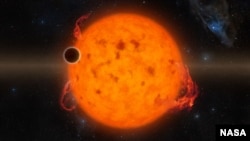Astronomers say they have found the youngest planet ever discovered outside our solar system.
The planet, called K2-33b, which was detected by the Kepler space telescope, is only 5 to 10 million years old and just slightly larger than Neptune. Unlike Neptune, which orbits the sun every 165 years, K2-33b travels around its star every five days. K2-33b is 10 times closer to its star than Mercury is to the sun.
"Our Earth is roughly 4.5 billion years old," said Trevor David of Caltech in Pasadena, lead author of a new study published online June 20, 2016, in the journal Nature. "By comparison, the planet K2-33b is very young. You might think of it as an infant."
How planets form remains a mystery, especially large planets orbiting so close to their stars. Most of the 3,000 or so exoplanets, planets outside our solar system, that have been discovered, are in star systems that are at least a billion years old.
There are two theories about how K2-33b formed. One holds that it “migrated” there in what astronomers call “disk migration.” That process takes hundreds of thousands of years, likely ruling it out as the way K2-33b formed. Another is that it could have formed “in situ,” or exactly where it is today.
"After the first discoveries of massive exoplanets on close orbits about 20 years ago, it was immediately suggested that they could absolutely not have formed there, but in the past several years, some momentum has grown for in situ formation theories, so the idea is not as wild as it once seemed," said David.
Researchers say there have been other, much older exoplanets found circling their suns very tightly, but how a planet as large as K2-33b got there has been more puzzling.
The Kepler telescope detected K2-33b using a process called the transit method in which the star dims ever so slightly as the planet passes in front of it.
The same issue of Nature also describes another new exoplanet orbiting a star called V830, which is 420 light-years from Earth. It is a Jupiter-sized planet orbiting one-twentieth the distance from Earth to the sun.









